by Celeste Lipford and Terry Lipford - last updated on 11/11/2025
We had been pondering what our next "adventure" should be, and at the same exact time, our daughter Chelsea expressed an interest in possibly attending the New York City Fashion Institute of Technology. We discovered that we had a bunch of Hilton Hotel points that we could put to use, and so we decided that we would make a trip to New York City.
A bit of map research showed that we could stay at the DoubleTree by Hilton Hotel & Suites Jersey City and be only a short walk from a PATH Subway Station, which would provide us with direct access to various stops in the city.
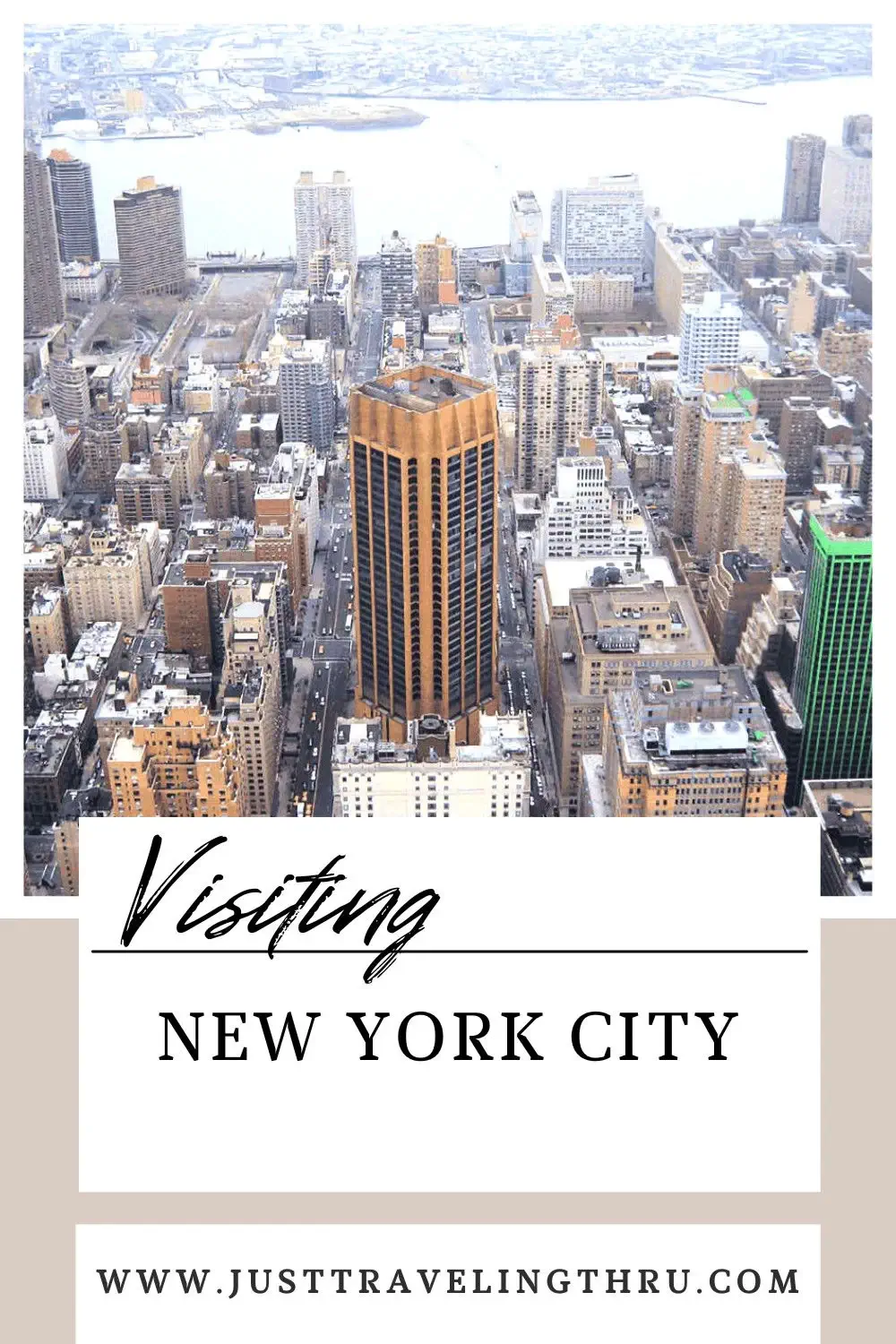
New York City from our Hotel Window
To amplify my previous statement about the view from the DoubleTree by Hilton Hotel & Suites Jersey City, these images of New York City were taken from our hotel room window. Great view of the Big Apple eh?
One of the standout features of this hotel is its convenient location. It's just a short commute away from Manhattan, with easy access to the PATH train system, making it an ideal choice for both business and leisure travelers exploring New York City. Jersey City itself offers a diverse culinary scene, and the hotel's on-site dining options provide delicious choices as well.
We took a ride on the PATH subway from our hotel in New Jersey, traveling under the Hudson River to lower Manhattan, where we emerged at the World Trade Center site. At the time of our visit, the area was still under construction, with cranes towering above and workers bustling about as they brought new life to Ground Zero.
It was a somber and reflective moment for all of us as we stood at the site where the Twin Towers once stood. The memories of that tragic day — watching the events unfold on TV, feeling the shock and grief shared by people around the world — came rushing back. Standing there in person brought an even deeper sense of the magnitude of what happened here.
Despite the sadness, there was also a palpable sense of resilience and renewal. The new One World Trade Center was rising steadily, a symbol of hope, strength, and determination. Seeing workers laying bricks and steel beams reminded us that life moves forward, and out of tragedy comes renewal.
Walking around the site, we also noticed the progress on the 9/11 Memorial, a powerful and moving tribute to those who lost their lives. The names of the victims were etched into the reflecting pools that mark the footprints of the original towers. The sound of water cascading down the sides of the memorial pools was both calming and emotional, as if the site itself was quietly mourning while encouraging reflection and healing.
Watching the Construction
As we stood overlooking the World Trade Center site, we couldn't help but be captivated by the bustling activity of the construction crews working tirelessly below us. The entire area was a hive of energy and determination, with workers carefully clearing debris, reinforcing foundations, and preparing the site for what would soon become One World Trade Center — a structure destined to be both a symbol of resilience and a beacon of hope for New York City.
Even in its early stages, the magnitude of the project was impressive. Towering cranes hovered over the site, and the sounds of machinery, hammers, and drills filled the air. We could see teams of workers moving swiftly, each contributing to the massive effort of rebuilding on what had once been sacred ground. Their focused precision and sense of purpose were evident, a reminder that this was more than just another skyscraper; it was a monument to perseverance and renewal.
When completed, One World Trade Center will stand 1,792 feet tall, proudly towering above the city streets as the tallest building in the Western Hemisphere. The height itself holds symbolic significance — a nod to the year 1792, when the Bill of Rights was ratified, underscoring the ideals of freedom and democracy that the new tower embodies.
Image Credit: Image # 2 is the property of Kushlar via Wikipedia Commons
The CBS Headquarters, also known as the CBS Building or "Black Rock," is a landmark skyscraper located at 51 West 52nd Street in Midtown Manhattan, New York City. Designed by renowned architect Eero Saarinen and completed in 1965, it stands as a masterpiece of modernist architecture. The 38-story tower is distinguished by its sleek black granite façade, which gives it a bold, minimalist aesthetic that contrasts sharply with the surrounding skyline.
At 491 feet tall, the building's innovative design emphasizes verticality, with precisely arranged window slits and chamfered edges that create a strikingly monolithic appearance. The CBS Building was Saarinen's only skyscraper project, reflecting his vision of a structure that embodies both strength and simplicity.
Originally constructed to house CBS's corporate offices, the building became an iconic symbol of the broadcasting giant during its heyday. It includes carefully curated interior spaces designed to balance form and function.
Today, the CBS Headquarters remains a celebrated piece of architectural history, admired for its timeless design and cultural significance in the media world. Its enduring presence on Manhattan’s skyline serves as a testament to mid-20th-century innovation and the legacy of Saarinen’s architectural genius.
POST EDIT NOTE: After Viacom acquired CBS in 2000, there were several attempts to sell this building, it was finally sold in 2021 to Harbor Group Investments (HGI).
Trinity Church, located at the intersection of Wall Street and Broadway in Lower Manhattan, is one of New York City's most historic landmarks. Founded in 1697, the church has stood as a symbol of resilience and faith through centuries of change. The current Gothic Revival building, designed by architect Richard Upjohn, was completed in 1846 and was once the tallest structure in New York, its spire reaching 281 feet.
Trinity Church’s ornate exterior features sandstone construction, pointed arches, and intricate stone carvings, embodying classic Gothic architecture. Inside, visitors are greeted by stunning stained-glass windows and an elegant vaulted ceiling. The church also houses an active parish, hosting regular services, concerts, and community events.
The surrounding Trinity Churchyard is a peaceful oasis amidst the bustle of the financial district, where notable historical figures such as Alexander Hamilton, Eliza Schuyler Hamilton, and Robert Fulton are buried. The adjacent St. Paul's Chapel, part of the Trinity parish, served as a refuge during 9/11 and is a site of reflection and history.
The Wall Street Bull, also known as the Charging Bull, is an iconic 7,100-pound bronze sculpture that has become one of the most recognizable symbols of New York City and the financial world. Standing 11 feet tall and stretching 16 feet long, the sculpture captures the powerful stance of a bull poised to charge forward, embodying the spirit of aggressive financial optimism, strength, and prosperity.
Created by Italian-American sculptor Arturo Di Modica in 1989, the bull was designed as a symbol of resilience and determination in the face of economic challenges. The artist chose the bull as his subject because it represents financial success and upward momentum, commonly associated with "bull markets" in the stock market, where prices are rising, and investor confidence is high.
The dynamic posture of the sculpture conveys a sense of raw energy and movement. The bull leans back slightly on its haunches, with its muscular body coiled and ready to spring forward. Its head is lowered, horns pointed, and nostrils flared, creating an impression of a powerful creature on the verge of charging ahead with unstoppable force. The bull's expression and posture suggest bold confidence, a reminder of the risk-taking spirit that drives the financial markets.
Originally, the sculpture was placed without permission near the New York Stock Exchange as a guerrilla art piece, but it was quickly embraced by the public and later moved to its current location in Bowling Green Park. Today, it attracts millions of visitors annually, who often rub its horns, nose, and, notably, its rear for good luck — a tradition that has turned parts of the sculpture a shiny golden color from repeated contact.
The southern tip of Manhattan, Battery Park. Jeremy is looking across the Hudson River at the Statue of Liberty on Liberty Island in New York Harbor. All of us had wanted to visit the Statue, but our time frame just could not accommodate that side-trip.
Quick Facts: The relatively modern Battery Park was mostly created by landfill starting from 1855, resulting in a landscaped open space at the foot of the heavily developed mainland of downtown Manhattan. Skyscrapers now occupy most of the original land, stopping abruptly where the park begins. On State Street, the former harbor front and the northern boundary of the park, a single Federal mansion, the James Watson House, survives as part of the Shrine of Saint Elizabeth Ann Seton; until the 1820s, the city's stylish residential district was north of this house, between Broadway and the Hudson River.
Always something going on in Battery Park; In the first (left) image, we had stopped to watch these guys perform, they were very good. Yep, you could say that their "goal" was to collect money from the crowd - but - they were talented and disserved whatever they collected!
And in the second (right) image (just around the corner) another group of entertainers. They were not near as talented as the other crew, but their ability to walk on stilts was impressive.
As our daughter was going to graduate high school soon, and she was very interested in fashion design, we scheduled a visit to the Fashion Institute of Technology on 27th street between 7th & 8th Avenues. This image is the David Dubinsky Student Center at 340 Eighth Avenue between 27th and 28th Streets.
Aspiring fashionistas, set your sights on the Fashion Institute of Technology (FIT) in New York City. This prestigious public college isn't just about clothes – it's a hub for all things fashion, design, business, and technology. Founded in 1944, FIT offers a vast array of undergraduate and graduate programs, from fashion design and textiles to jewelry making and fashion marketing. Beyond academics, FIT fosters creativity with its on-campus galleries, including the renowned Museum at FIT showcasing fashion history through exhibits. Hone your skills in industry-standard labs and studios, and gain invaluable experience through internships and career fairs. Located in the heart of NYC's vibrant fashion scene, FIT provides unparalleled access to the industry, making it a dream destination for anyone passionate about the world of fashion.
We decided to start our exploration by taking the subway to the Natural History Museum, because it is one of the largest natural history museums in the world. In Theodore Roosevelt Park the museum complex comprises 26 interconnected buildings housing 45 permanent exhibition halls, in addition to a planetarium and a library. The museum collections contain over 34 million specimens of plants, animals, fossils, minerals, rocks, meteorites, human remains, and human cultural artifacts as well as specialized collections for frozen tissue and genomic and astrophysical data, of which only a small fraction can be displayed at any given time, and occupies more than 2 million square feet (190,000 m2). The museum has a full-time scientific staff of 225, sponsors over 120 special field expeditions each year, and averages about five million visits annually.
Since there is a subway station at 81st street & Central Park West, the Museum is easy to get to and it is directly across the street from Central Park.
After our Museum of Natural History exploration, we walked through Central Park to 5th Avenue, turned south, and walked down to the Public Library building at 476 5th Avenue - just a few blocks north of the Empire State building.
The New York Public Library is the second largest public library in the United States (behind the Library of Congress), and fourth largest in the world.
Quick Facts: The Stephen A. Schwarzman Building, commonly known as the Main Branch or the New York Public Library, is the flagship building in the New York Public Library system and a landmark in Midtown Manhattan, New York City. The branch, one of four research libraries in the library system, contains nine separate divisions. The structure contains four stories open to the public. The main entrance steps are at Fifth Avenue at its intersection with East 41st Street. As of 2015, this branch contains an estimated 2.5 million volumes in its stacks.
NOTE: The above information is from Wikipedia, click here to view the Wiki Page.
Building Statistics
| Construction Start: | March 17, 1930 |
| Construction End: | April 11, 1931 |
| Height at Tip: | 1,454 feet |
| Height at Roof: | 1,250 feet |
| Floors: | 102 |
| Elevators: | 73 |
| Weight: | 365,000 tons |
| Volume: | 37 million cubic feet |
Building Quick Facts
The building was designed by Shreve, Lamb & Harmon and was completed in 1931. It's name is derived from "Empire State", the nickname of New York, which is of unknown origin.
As of 2019 the building is the 5th-tallest completed skyscraper in the United States and the 28th-tallest in the world. It is also the 6th-tallest freestanding structure in the Americas.
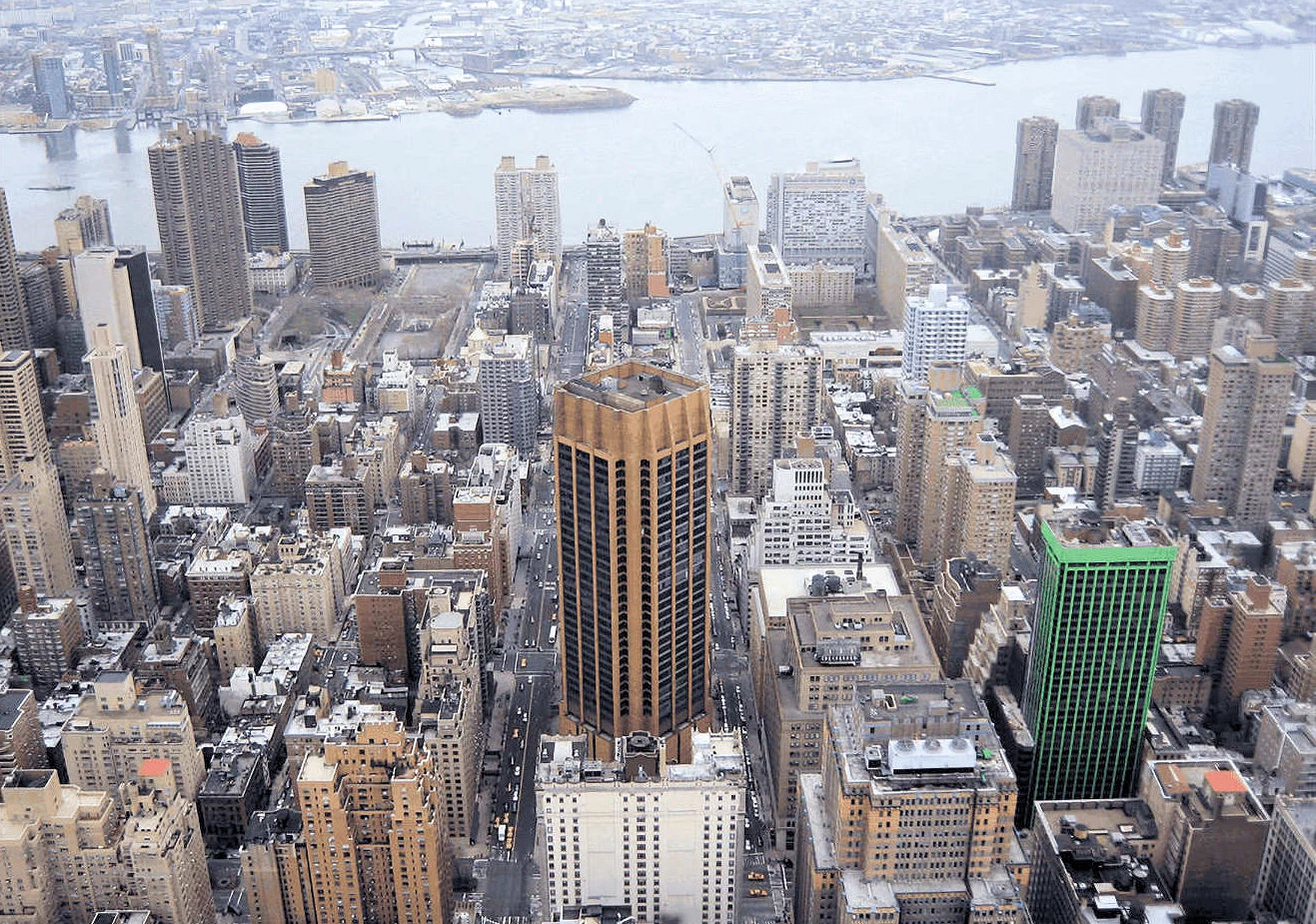 Empire State Building: Looking East
Empire State Building: Looking East
We took the Empire State Building tour, and the view of the city below was incredible! This is looking east, towards the East River. That bronze colored building is 3 Park Avenue, a mixed-use office building and high school located at East 34th street & Park Avenue, that was built in 1973.
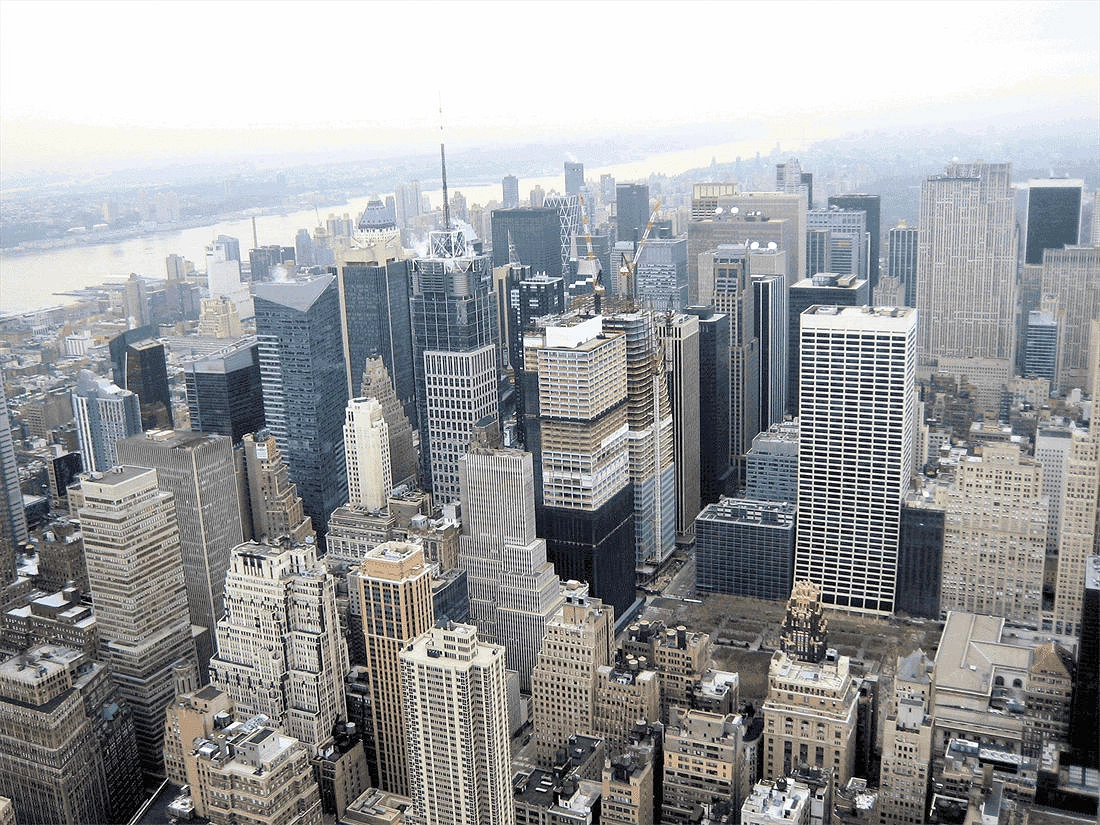 Empire State Building: Looking South
Empire State Building: Looking South
As I was saying, the view from the top of the Empire State Building is just amazing. This is looking south, that is the East River on the left.
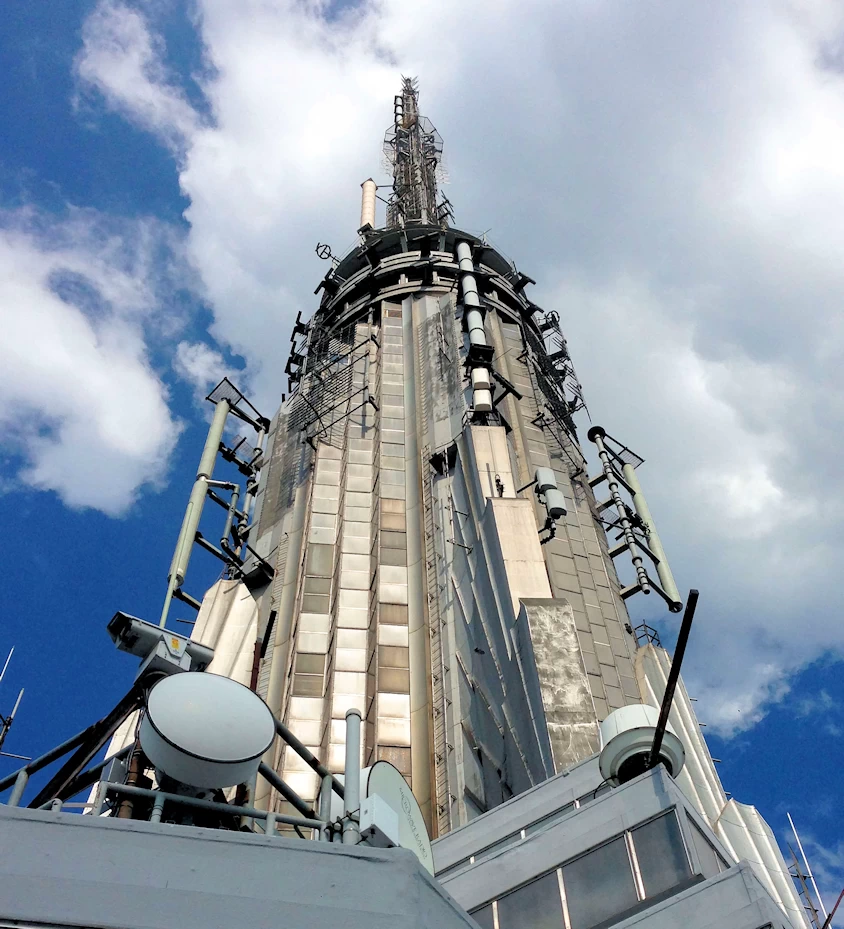 Empire State Building: Looking Up
Empire State Building: Looking Up
Looking up from the Empire State Building Observation 102nd floor observation platform, you can see where King Kong climbed up to the very top.
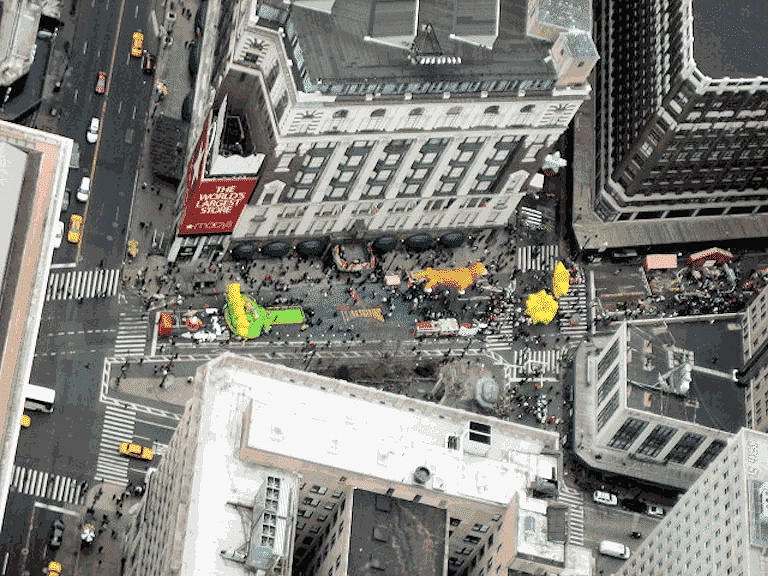 Empire State Building: Looking Down
Empire State Building: Looking Down
Looking down from the Empire State Building Observation deck. If you are even slightly bothered by heights, this might not be a good view for you ! The observation decks are located at the 86th and 102nd floors - the 102nd floor one is just about at 1,250 feet above street level.
After our Empire State Building tour, we descended to ground level and decided to walk about the Manhattan area. You can see by the crowds that it is obviously a week day lunch time!
Manhattan is a shopper's paradise, offering everything from high-end luxury to quirky vintage finds. Fifth Avenue is the undisputed king of luxury, with iconic brands like Gucci and Prada lining its prestigious streets. Venture beyond the main avenues and discover SoHo's trendy boutiques, or head to the Meatpacking District for edgy designer stores. Don't miss the department store haven of Herald Square, housing Macy's and Bloomingdale's, perfect for one-stop shopping sprees. For vintage treasures, dive into the East Village's thrift shops or browse the unique stalls of Brooklyn Flea, a weekend market brimming with hidden gems. Whether you crave designer labels or one-of-a-kind finds, Manhattan's diverse shopping scene guarantees an unforgettable experience.
Shopping in Manhattan: Click here to view a Google Search Results list for shopping in Manhattan.
Could there be a more famous name than this? Radio City Music Hall was built on a plot of land that was originally intended for a Metropolitan Opera House. The opera house plans were canceled in 1929, leading to the construction of Rockefeller Center. The new complex included two theaters, the "International Music Hall" and the Center Theatre, as part of the "Radio City" portion of Rockefeller Center.
Step into the glitz and glamour of New York City's Radio City Music Hall, a landmark of art deco architecture and dazzling entertainment. Opened in 1932, the Music Hall boasts the iconic Rockettes, a precision dance troupe famous for their high kicks. Catch the legendary Christmas Spectacular, a festive extravaganza featuring dazzling costumes, heart-warming stories, and a live orchestra. Beyond the iconic show, Radio City Music Hall stages concerts, special events, and movie premieres. With its opulent interior, rich history, and unforgettable performances, Radio City Music Hall offers a quintessential New York City experience.
Plan Your Visit to New York City Travel Resources — Maps, Parking, Passes & Links
Quick Subway Wins
Tap with OMNY (contactless) and you’ll hit the weekly fare cap automatically—no MetroCard lines needed. Avoid rush hour for popular sights when possible.
Best Views on a Budget
Ride the free Staten Island Ferry for skyline and Statue views, then return for dusk photos. For observatories, book sunset slots in advance.
Planning Your Trip
When is the best time to visit NYC?
The best time depends on your preferences, ie;
How many days should I visit NYC?
Most first-time visitors spend at least 3 to 5 days to see the major highlights across different boroughs. This allows enough time to explore key attractions without feeling rushed.
What are the "must-see" attractions in NYC?
Key attractions include the Statue of Liberty, Times Square, Central Park, Broadway shows, the Empire State Building, various museums (e.g., Metropolitan Museum of Art, American Museum of Natural History), and different neighborhoods like Greenwich Village, SoHo, and Brooklyn.
Do I need a visa to visit NYC?
International visitors may need a visa. Citizens of countries in the visa-waiver program (including the EU, UK, Australia, Japan) can apply online for an ESTA (Electronic System for Travel Authorization) a few days before travel.
Getting Around and Accommodations
What is the best way to get around NYC?
The subway is the most efficient and authentic way to travel long distances. It operates 24/7. For shorter distances and sightseeing, walking is the best way to experience the city's neighborhoods. Taxis and rideshares are readily available but can be slow due to traffic.
How do I use the subway and how do I pay for it?
You can pay for rides by using your contactless credit/debit card, smartphone, or wearable device at any OMNY turnstile ("tap and go"). You can also buy a reusable OMNY card or a MetroCard at a subway station vending machine. The fare is currently $2.90 per ride.
Where should I stay in NYC?
Dining and Entertainment
How much should I tip at restaurants and bars?
Where can I find the best pizza and bagels?
NYC is famous for its pizza and bagels, and many places claim to be the "best." Popular spots often mentioned include Katz's Deli for pastrami, and various local pizzerias and bagel shops in different boroughs (Flushing and Sunset Park have great, authentic Chinese food options, too). Exploring local spots away from Times Square is often recommended.
General Knowledge & Culture
Is New York City safe?
New York City is generally safe for tourists, especially in busy, well-trafficked areas. As in any major city, you should be aware of your surroundings and take standard precautions against pickpockets, especially in crowded tourist spots like Times Square or on the subway. For what it is worth, we experienced no issues while we were there.
Why is New York City called the "Big Apple"?
The nickname "The Big Apple" became popular in the 1920s jazz era. Jazz musicians used "apple" to refer to a gig, and the "Big Apple" was the most important one: New York City. A sportswriter later popularized the term.
Is New York City wheelchair friendly?
New York City is a mix of highly accessible modern infrastructure and challenging older systems. While many major attractions, public buildings, and transportation options are wheelchair accessible, navigating the city can still present some difficulties.
Accessible Aspects of NYC
Challenges for Wheelchair Users
New York City Restaurant Suggestions
New York City has approximately 28,000 restaurants, though specific numbers vary depending on the source and time frame. Some estimates suggest there are around 15,000 to 15,423 restaurants, while a 2021 study using OpenTable data found over 8,200 businesses listed on their platform.
We suggest Google Search for finding a restaurant that would meet your requirements and this is because you can "tune" Google Search to find restaurants by rating, cuisine, price, hours, etc. So to provide you with some usable information, here is a list of Google Search Results (SERP) filtered by "highest rating" and "cuisine type". Each of the following links will take you to a Google SERP where you can change the search filters as you prefer;
Note: All images featured on this page are the exclusive property of Just Traveling Thru, LLC, unless otherwise stated. When images from external sources are used, full credit is given to the original creator, along with a link to the specified license or usage terms. We are committed to respecting copyright and intellectual property rights, ensuring that all third-party images are properly attributed. If you have any questions regarding image ownership or usage rights, please feel free to contact us.
Affiliate Links: We may earn a commission if you make a purchase through one of our affiliate links. This helps support our travel content — thank you!
Content: To review any of our content, make suggestions and/or comments, please click the "About" menu link at the top of this page. You will find our "Contact Us" link on that drop-down menu.